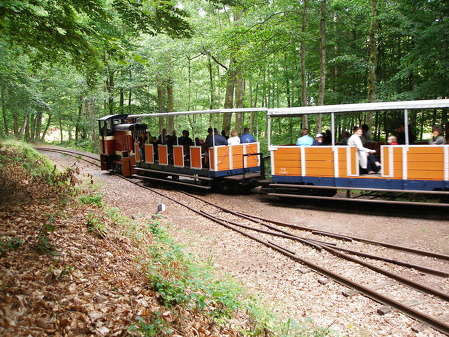History of the Association and
the Abreschviller Line – Grand Soldat
the Abreschviller Line – Grand Soldat
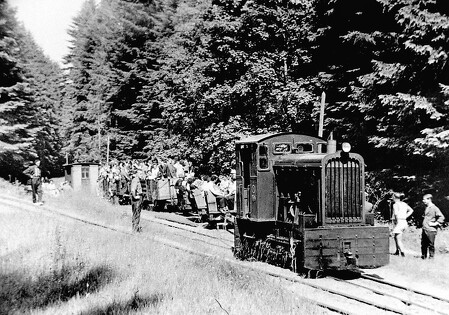
The lovers of hiking, who criss-crossed the Vosges paths between Abreschviller and the Donon massif could not, about forty years ago, cross or follow one of the many valleys of the Donon towards Abreschviller without encountering a railway track with an unusual gauge of 70 cm.
If taken by curiosity, one or the other followed this track, it did not usually have a long journey to make before meeting, either a siding on which loaded log cars were parked, or a branch line that was travelling to a woodlot during logging.
If taken by curiosity, one or the other followed this track, it did not usually have a long journey to make before meeting, either a siding on which loaded log cars were parked, or a branch line that was travelling to a woodlot during logging.
While most knew that the road thus encountered belonged to the network of the Abreschviller Forest Railway, few knew its history, its consistency and the way in which it was operated. Nowadays, only the last six closest kilometres to Abreschviller, which are used for tourist purposes, remain.
So, before the night of time has cast the veil of oblivion, it seems interesting to recall the origin and history of this network which, according to the experts, was at its height, one of the most important forest railways in Europe.
So, before the night of time has cast the veil of oblivion, it seems interesting to recall the origin and history of this network which, according to the experts, was at its height, one of the most important forest railways in Europe.
Geographical and economic situation:
The northern part of the DONON massif (elevation 1008 m) is made up of vast, hilly forest areas, with a afforestatio n rate of 80%.
The state forests of Abreschviller, Walscheid and Saint-Quirin form a massif of 11,500 hectares in one piece, between altitudes of 300 to 1,000 metres.
Several valleys : Sarre Blanche, Sarre Rouge, Zorn Jaune, Ruisseau d’ Abreschviller and t heir tributaries come down from the massif.
This forest consists of 75% softwood and 25% hardwood (beech and oak) and produces about 75,000 m3 of wood per year.
It is managed by the Office National des Forêts (National Forestry Board).
The state forests of Abreschviller, Walscheid and Saint-Quirin form a massif of 11,500 hectares in one piece, between altitudes of 300 to 1,000 metres.
Several valleys : Sarre Blanche, Sarre Rouge, Zorn Jaune, Ruisseau d’ Abreschviller and t heir tributaries come down from the massif.
This forest consists of 75% softwood and 25% hardwood (beech and oak) and produces about 75,000 m3 of wood per year.
It is managed by the Office National des Forêts (National Forestry Board).
For a long time, the low population density and the scarcity of penetrating routes of communication generated the under - exploitation of this forest.
From the few operating centres located in the least difficult to reach areas, the felling timber was transported by slurry or by oxen carts to small sawmills located along the rushing creeks from which they drew their driving power.
Water was often used to float their production downwards.
From the few operating centres located in the least difficult to reach areas, the felling timber was transported by slurry or by oxen carts to small sawmills located along the rushing creeks from which they drew their driving power.
Water was often used to float their production downwards.
Appearance of the railway :
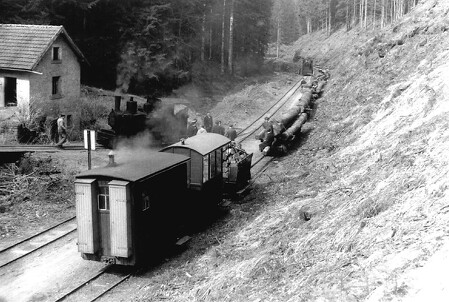
By the 1850s, the forest service had set up an extensive program for building forest roads, which was only partially completed.
In 1884, the German Forestry Administration replaced the project of forest roads with the construction of a railway going up the creek of Abreschviller from the ZWEIBACH site over a l ength of 5 km, which was soon extended to 13 km in 1888.
The chosen gauge was that of the military railways of Prussia, that is 70 cm.
This is the only known case of introduction in France of this type of gauge.
A few years later, a project to build a standard gauge railway between Sarrebourg and Abreschviller is being studied.
The question arises as to whether the line with standard gauge should be extended to the lower terminus of the forest railway at ZWEIBACH or whether the latter should be lowered to Abreschviller.
The establishment of large sawmills in Abreschviller, including a state-owned sawmill managed by the forest administration, led to the second solution : the normal route will stop at Abreschviller, whose SNCF station will be built in 1892.
Extension of the forestry railway :
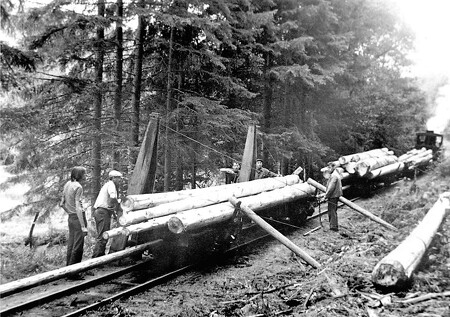
On March 30, 1892, a severe storm similar to that of December 26, 1999, devastated the massif and knocked down about 200 000 m3 of wood.
Faced with this enormous quantity of materials to be exploited quickly, the German Forestry Administration of the time immediately carried out all the projects to extend the narrow line under study, that is approximately 35 km (not including sidings ) which were built in four months.
Equipment was purchased and a workshop for the maintenance and repair of this equipment was set up in Abreschviller, near the state-owned sawmill.
Since July 5, 1892, the first steam trains criss- cross the massif.
A few years later, once the storm-felled timber from 1892 was exploited, the forest administration considered that the development of the railway was too important for normal needs.
After study, part of the existing network was declared useless : the track was removed, the rails and the surplus equipment were sold.
In 1902, a new storm put the forest administration in front of 180,000 m3 of timber to be exploited. A new extension of the network was decided.
In 1918 it consisted of 50 km of tracks. It continued to extend until 1939 to reach about 73 km including 9 km of siding and garage.
Faced with this enormous quantity of materials to be exploited quickly, the German Forestry Administration of the time immediately carried out all the projects to extend the narrow line under study, that is approximately 35 km (not including sidings ) which were built in four months.
Equipment was purchased and a workshop for the maintenance and repair of this equipment was set up in Abreschviller, near the state-owned sawmill.
Since July 5, 1892, the first steam trains criss- cross the massif.
A few years later, once the storm-felled timber from 1892 was exploited, the forest administration considered that the development of the railway was too important for normal needs.
After study, part of the existing network was declared useless : the track was removed, the rails and the surplus equipment were sold.
In 1902, a new storm put the forest administration in front of 180,000 m3 of timber to be exploited. A new extension of the network was decided.
In 1918 it consisted of 50 km of tracks. It continued to extend until 1939 to reach about 73 km including 9 km of siding and garage.
Operating the forestry railway :
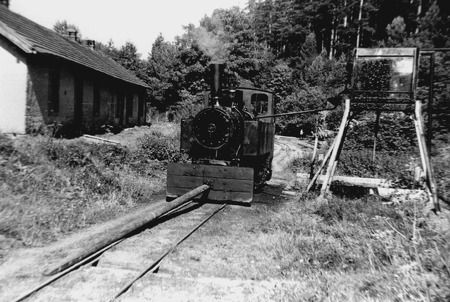
Every day, two trains served the network : one the line of the Zorn, the other that of the Sarre Rouge and the stream of Abreschviller.
In the morning, they brought the empty wagons and left them a short distance upstream from the loading sites.
The wood cut in the forest and lowered to the railway track by 2 lumberjacks was loaded on the cars with a winch system.
They were then taken by gravity to the nearest siding downstream and picked up at the end of the day by the train to Abreschviller.
Each car was coupled to the next and the previous one, as well as to the locomotive by a long fretted wood pole with a coupler ring at each end.
This system allowed for a large overhang of the load at the ends of the cars, faci litating the transport of the long logs without problems of stability or position in the curves.
Each train could carry 50 to 70 tonnes of logs.
The number of employees employed in railway operations (including shippers and maintenance staff) was approxi mately 50.
Annual traffic was of the order of 35 to 40,000 m3 around 1958, about half of the timber production of the entire forest, the other half was carried directly by the road which was increasingly penetrating the massif.
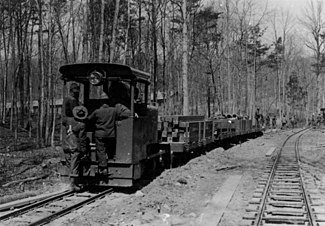
The decline of the railway network :
In 1960, the timber routes consisted of 61 km of railway tracks and 92 km of roads (42 km of forest roads and 50 km classifie d in public roads).
The track and rolling stock exhibited significant wear and tear that would have required signif icant maintenance or even renewal. On the other hand, logging trucks and forestry tractors with trailers appeared,t he use of which was more flexible and more advantageous than the railway : the timber loaded in the very heart of the forest could be transported directly, without further handling, to the user.
These considerations led the forestry administration to decide on the gradual withdrawal of the railway line and the implementation of an 85 km road programme, 48 of which were intended to replace the Sarre Rouge line which already ran along the Donon road over a dozen kilometres.
A complementary programme of trails and dragging tracks to facilitate the approach to wood was carried out.
The dismantling of the railway began in 1962. In 1964, 40 km of tracks were removed and by the end of 1966, after 75 years of good and loyal service, the railway network ceased to be used for the transport of wood .
Tourism conversion :
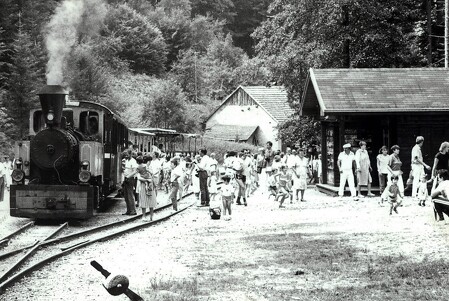
At the end of the exploitation of the timber transport network, the Forestry Administration had already made it available for several years to groups of tourists who requested it.
On some saturdays and sundays, tourist trips were organized.
Thus, as soon as the abandonment project of the railway was known, the idea of maintaining a line section for the purpose of tourist exploitation took shape in agreement with the Abreschviller tourist office.
With the support of the Forestry Administration, the Strasburg delegation of the Federation of Friends of Secondary Railways (FACS), chaired by Doctor SINGER, set up a committee for the resumption of a section of line and its regular exploitation on summer weekends.
It was first considered to exploit the ABRESCHVILLER-BRECHPUNKT route, that is to say about ten kilometres.
The end of this route was particularly rugged, with two successive turns to allow to overcome a significant difference in altitude.
This situation would have required special traffic constraints from the time it was a question of transporting people.
It was soon found that this difficulty as well as the distance to travel would have considerably increased operating costs.
Therefore, in order to be able to propose the trip at a fair price, the Committee quickly realized that it had to limit its ambitions.
This is how the ABRESCHVILLER-GRAND SOLDAT line was chosen, namely 6,100 km.
The initial Committee, after its transformation into the Association du Chemin de Fer Forestier d'Abreschviller (ACFA), could benefit from various subsidies and from June 1968, a regular weekend s ervice worked with the diesel locomotive that required the least refurbishment costs, and three platforms equipped with open cars.
This first operating year was a success, exceeding the most optimistic predictions as more than 10,000 tourists were transported during the season.
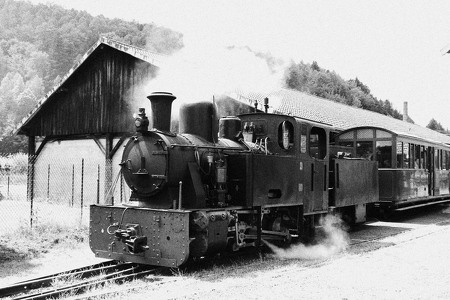
Encouraged by this success, the Association redoubled its efforts, allowing it to develop the terminus of Grand Soldat, to renew some sections of track that were in great need, to restore the steam locomotive Heilbronn 02-20 T, Mallet system, to get two closed passenger cars which were transferred on very favourable terms by the Swissrailway of the Wengenalpbahn (line that serves the massif of the Jungfrau near Interlaken).
The transformation of the running gear was carried o ut in the workshops of the Association to allow these cars to run on the gauge of 70 cm while they were designed to run on tracks with a gauge of 80 cm.
At the same time, the local branch of the Club Vosgien was concerned to mark up some new circular wal ks on the outskirts of the terminus of Grand-Soldat, which is also awell-known hamlet since it is possible to see the birth place of Alexandre Chatrian born in 1826, writer and railway worker, author with his friend Erckmann from Phalsbourg of a series of novels, the best known of which is «L'ami Fritz».
This is how we arrive at April 20, 1969, which marks the official date of the second birth of the Forestry Railway, since it was on that day that, under a cloud of snow and in the presence of many local and departmental personalities, Mr Pierre MESSMER, then Minister of Armies, cut the symbolic ribbon of the inaugural train that shook shortly afterwards, by spewing smoke and steam under the cheers of the crowd and the accents of an air of folklore played by the Harmony «La Vosgienne» of Abreschviller.
Since that day, the second steam engine has been refurbished (Decauville), 2 cars bought in Orléans, two built on existing boggies, a third steam engine 030 with separate tender (JUNG 1944) purchased in Austria, the tracks developed at the start and at the terminus were completed by a 2,500 km completely rebuilt and ballasted line, station-counters built at the start and at the terminus, thanks to the assistance of the Tourist Office of d'Abreschviller.
The first year’s 10,000 travellers per season (may-october) increased to 25,000 and 35,000 by 1971. Since then, attendance has ranged from 25 to 30,000 per season.
